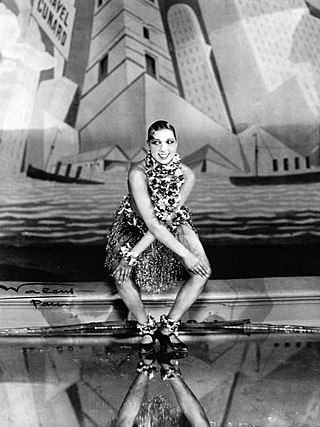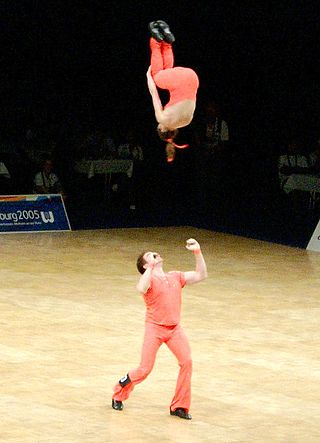This article needs additional citations for verification .(January 2023) |
The Tranky Doo (also called Trunky Doo) is a jazz dance choreography.
A source[ vague ] states it was choreographed by Frankie Manning himself and ″...named in tribute to the chorus girl who inspired it.″ [1]
At that time, it was danced to Tuxedo Junction , however many modern day performances of the dance use other swing jazz songs. It is most common these days to perform the dance with the song "Dipsy Doodle" by Ella Fitzgerald because the dance appears in the Spirit Moves documentary film with a playback of the song. However the film originally had no sound, and the song "Dipsy Doodle" was artificially superimposed on that section of the film. Dipsy Doodle's structure does not fit the structure of the Tranky Doo, since the song is a 12-bar blues structure and the choreography is 32-bar swing structure.
It was common to Lindy hoppers, like the shim sham.
Step List:
Fall off the Log: Kick R on 8, L on 4 - (1) 8 count
Shuffles: step R L R L on +8+1; side-press-lunges: step R on 2, press L on 3, step L on 4 press R on 5, etc. - (1)8 count
Repeat
Forward-press-lunges: Start facing R, step R on 8, press forward on 1, hold 2.3; step L on 4, press forward on 5, clap 6.7 - (1) 8 count
Boogie Forward - (1) 8 count
Repeat
Apple Jacks - (2) 8 counts
Rocks facing R - (1) 8 count
Rocks facing forward - (1) 8 count
Boogie Back - (1) 8 count
Shorty George - (1) 8 count
Boogie Back - (1) 8 count
Break Step - (1) 8 count
Knee Slap, ba-da-dum: Slap R knee on 8 hold for 1, step R L R on +.2.3; repeat to L and R once more. [ala Big Apple] - (1.5) 8 counts
Transition: Cross L over R on 4, step R on 6, clap 7 - (.5) 8 count
Suzie Q: start L on 8 - (1) 8 count
Reverse Break: Kick R across L on 8, rock step 2.3, lock turn 4.5.6.7 - (1) 8 count
Mess Around - (1) 8 count
Fall off the Log turning: Kick R on 8, perform 1/2 the Fall off the Log while turning to the left; plant feet together 3, spread 5, together with weight L on 7. End facing forward. - (1) 8 count
Eagle Slide: Kick-ball-change step scoot step kick-ball-change lock turn. Timing is 8 + 1 2 3 4 5 + 6 7 8
Drop Boogie: R 1.2.3.4; L 5.6.7 together 8 - (1) 8 count
Mambo Walks: Tap R on 2, cross over L on 3, tap L on 4, cross over R on 5, etc. - (1) 8 count
Push Turn (paddle turn): Keep weight on L 1.2.3.4 while pushing out with R on 1 and 3, step R on 5, step L on 6, down on 7, kick R on 8 (turns 360 degrees) - (1) 8 count
Fall off the Log turning: perform 1/2 the Fall off the Log while turning to the left; plant feet together 3, float back on R 4.5.6.7.8 - (1) 8 count
Truckin': Start L on 1 - (2) 8 counts
Float Back on R 1.2.3.4.5.6.7, step L on 8 - (1) 8 count
Low Cake Walk - (1) 8 count
Walk About - (2) 8 counts
Box Step: Start crossing L over R on 1 - (3) 8 counts
Shouts: Pop hips Back 1.2, Forward 3.4, R 5.6, L 7.8 - (4) 8 counts
Clap and Point: Start with weight on L, point R leg out on 1, clap as the knee comes up on 2, etc. - (4) 8 counts
Repeat from the top until music ends.








